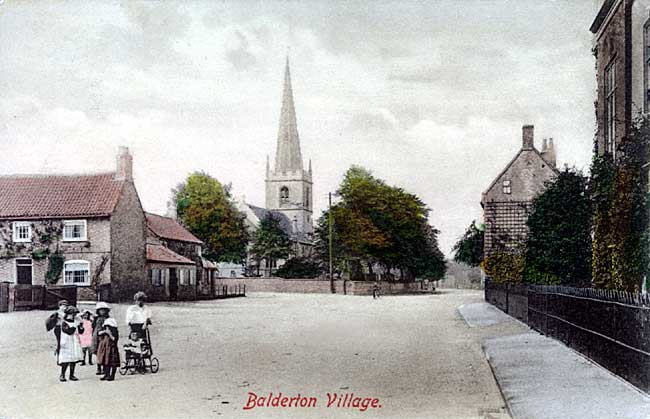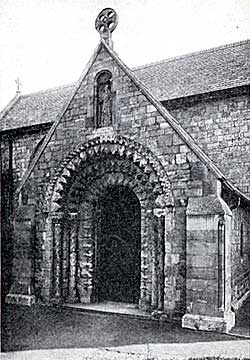Balderton

Balderton village view, c.1913.
"COMING home from Southwell to Newark in 1743, I saw part of the Roman road from Newark to Stamford going off on the right hand a little on this side of Balderton turnpike, where it mounts high grounds, being cornfields." Thus wrote Stukeley, and although this antiquary is not always a safe guide, there is no doubt that the Romans were hereabouts, for Balderton is not far from their Fosse-way and near to Newark. Roman coins, have been found, but whether there was ever a Roman settlement or even a villa is doubtful.
Cornelius Brown thought not, and suggested that these scanty finds were the droppings of casual travellers. In the present state of knowledge of Roman Notts, it must be assumed that the pockets of 2,000 years ago were singularly defective.
Of Saxon creation.
The village was of Saxon creation, and being near the Witham and the Deven, and not far from the Trent, its waterways may have led the invaders to its gravelly soil at an early date. They called it the "ton" or farm of one Balder, named after their god of beauty, the reputed son of Odin, but there is no evidence to support the tradition that they erected a heathen temple on the site of the present church, though their successors probably provided a small timber structure for Christian worship. At the time of the Conquest the hamlet was a dependency of the great manor of Newark, for whose owner its inhabitants were doing boon-work, or personal service, ploughing, sowing, weeding, mowing, reaping and carrying and rendering "twenty-four hens and four parts of a hen" as customary rent at Christmas. The famous Lady Godiva of Coventry fame— whose husband, Earl Leofric, was the friend and companion of the Confessor-King, was then lady of the manor of Newark, which she gave, with its appurtenances here, to the monastery at Stowe, from which it soon passed to the Bishopric of Lincoln. Hitherto, Balderton appears not to have been manoralised, but now was formed a manor which descended from the Dyves to the Bussys in the time of Edward I, and in the 16th century from them to the Meeres of Lincolnshire, who sold it to Giles Fenton, from whom it went through the Leekes to George Lascelles, of Elston.

The Norman porch at Balderton church.
Although the coming of the Normans seriously impaired the prosperity of the village for a while, it made quick recovery, and when the Pentecostal offerings at Southwell were established in 1171, this parish was rated above the local average. About that period some of its lands and tenements were given to St. Katherine's Priory by Lincoln, and in the following century the Great North Road (Stukeley's Roman road), which enters the county just south of the village, superseded the old route to the north which, says Professor Swinnerton, went via Nottingham and Sutton-in-Ashfield to Bawtry. It was near the end of the 13th century that the manor descended from the Dyves to the Bussys, and the records of the period present a picture of typical mediaeval village conditions.
There were a dovecote and a windmill on the manor, as well as a capital messuage or hall, and the feudal system of agriculture was in full swing. Bondmen had to work with eleven harrows once a year for a halfpenny a day: they had to plough two days a year; they sowed the lord's corn and vegetable seeds and were provided with drink only at the Lent sowings; in summer they had to do 115 days' work weeding and sowing. The cottars paid a rent, in autumn they rendered 36 days' work without food, and at Christmas the tenants paid 42 cocks and hens and in return were entertained at the manor house. They were subject to the manorial courts and the cottars paid "stuth" —a fine to their lord whenever a daughter of theirs married. Vines were cultivated then and long afterwards, doubtless for the production of the lord's wine.
Lawlessness.
The village had its full share in the lawlessness that prevailed under the later Plantagenets. In 1290 two outlaws, who had taken sanctuary in Newark Church and had been allotted a route to a port to quit the realm, departed from the prescribed way and committed another robbery; they were pursued and caught at Balderton and straightway beheaded. In quick succession a man was found here murdered and stripped, and Wm. de Orston was robbed and murdered. A year later, 1313, a man was robbed of his goods by thieves who beat him so unmercifully that he died. The warden of St. Leonard's Hospital at Newark did not scruple to block up the highway to the common pasture by building a wall across it. In 1332 Hugh Gamel was outlawed for a trespass here. Four years later, Balderton Grange was broken into and pillaged, a carter, who saw the offenders, being slain, but the hue and cry was raised and at Hawton the marauders were
caught and beheaded. In 1340 the collectors, of the King's tax were busy seizing moneys for themselves; from Balderton they illicitly took 12s. Nine years afterwards came the Black Death which doubtless exacted a heavy toll.
Lighter Tones.
These were the darker shades, but there were lighter tones. Law-abiding folk were ornamenting, their even then old church. In 1326 Wm. Durrant, of Newark, gave Balderton property to the Hospital of St. Leonard at Newark, and later Simon de Surfleet and Wm. de Wakebrugge endowed a chantry in Newark Church with lands and tenements here and elsewhere. At that period rope-making became a village industry and flourished for several centuries.
The deposition of Richard II in 1399 had a sad repercussion at Balderton; its lord. Sir John Bussy, had been secretary to that unfortunate monarch and one of his evil counsellors, and when Henry IV ascended the throne one of his first actions was to consign him to the block. Ere then the Pierrepoints had established a footing, having the fourth part of a fee, and presently Sir Henry Pierrepoint was suing Hy. Sotehill for detention of deeds relating to property in the village and its fields.
Sir Miles Bussy, lord "of the manor of Balderton-cum-Coddington-cum-Barnby," died in 1525 on the eve of great excitements and changes, of which the first was a riot. The townsfolk of Newark were in hot dispute with the Bishop of Lincoln concerning tolls and cattle rights, and in 1534 the bishop's agent, Anthony Forster, drove away their cattle from the precincts of the church. A melee ensued and it is said that the church bells were rung backwards—always a tocsin of alarm—that their sheepfolds were thrown down and the lives of shepherds imperilled. Forster and his men made for Balderton and such scenes of violence ensued that one householder whose house had been invaded and despoiled died of the injuries he received, and people fled into the church for their lives. The case came before the Star Chamber, but the result was not recorded.
